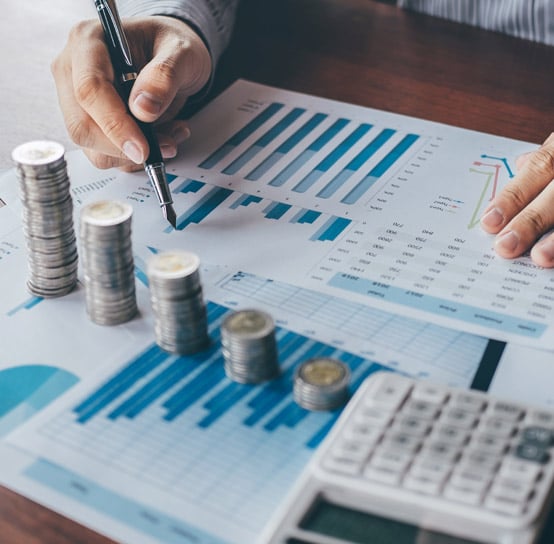-
Business Consulting
Our business consulting specialists offer a comprehensive blend of strategic advisory services. We assess the business, industry, operating model, synergy, skill sets and vision of the organisation and recommend the way forward
-
Digital Natives
Unlock growth with Grant Thornton Bharat's Digital Natives solutions. Customised support for tech-driven companies in healthcare, gaming, and more.
-
Digital Transformation Services
Grant Thornton’s digital transformation services help traditional businesses digitalise their business models with cloud technology, IoT consulting, app development and more DigiTech solutions.
-
Finance Transformation
Using a holistic approach, integrating digitalisation and digital transformation we help clients achieve transparency, control, governance, and faster decision making through real-time data within the business.
-
Human Capital Consulting
Our Human Capital Consulting team harnesses technology and industry expertise to assist in constructing adaptable organisations with transparency, fostering productive and value-driven workforces, and inspiring employees to engage meaningfully in their tasks.
-
Production Linked Incentive Scheme
Production-linked Incentive Scheme by the Indian government is aimed at boosting manufacturing. Grant Thornton Bharat offers varied services across sectors to help businesses avail of this scheme.
-
Public Sector Advisory
Our Public Sector Advisory team has focused streams, aligned with the core priorities of the Government of India. We are responsible for providing innovative and customized technical and managerial solutions.
-
Tech Advisory
We have amalgamated Digital Transformation, IT Advisory & Information Management and Analytics into a new offering, DigiTech.

-
Direct Tax services
Our tax specialists offer a comprehensive blend of tax services, tax litigation, regulatory and compliance services, helping you navigate through complex business matters.
-
Indirect Tax Services
Get tax services by leading tax firm Grant Thornton India. Our indirect tax services include consulting, compliance and litigation services for corporate, international and transaction tax
-
Transfer pricing services
Our transfer pricing services experts provide a range of services from provision of APA services to handling large global assignments including Country by Country reporting.
-
US Tax
At Grant Thornton, we help individuals and dynamic companies deal with US tax laws, which are one of the most complicated tax legislations across the world.
-
Financial Services - Tax
Best financial advisory services, tailored for small and large businesses by the experts having comprehensive knowledge of domestic laws and access to multifaceted tools to provide a valuable results.
-
Financial Reporting consulting services
Our experts have significant hands-on experience in providing IFRS/US GAAP services, end-to-end solutions and support services to fulfil financial reporting requirements.
-
Fund accounting and financial reporting
International operations often lack standardisation and have varied local reporting formats and requirements. Our experts can offer proactive insights, practical guidance, and positive progress and help meet regulatory timeframes.
-
Compliance and Secretarial Services
Our experts can assist in overhauling the entire compliance machinery of the organisation through evaluation of the applicable statutory obligations, monitoring of adequate governance controls, reporting and providing ongoing support.
-
Global People Solutions
As businesses transcend borders, both domestic and global considerations need equal attention. Our interim CFO and financial controller support services help organisations meet the business vision.
-
Finance and accounting outsourcing
Our accounting experts assist organisations in managing their accounting and reporting. Our dedicated Integrated Knowledge and Capability Centre (IKCC), allows us to service both the domestic and global markets efficiently and cost-effectively
-
Compliance Management System
We have automation solutions for you that will allow meeting government requirements and remain diligent, which when failed, can lead to penalties and loss in revenue.
-
Global compliance and reporting solutions
At Grant Thornton Bharat, we meet the challenges of our clients and help them unlock their potential for growth. Our professionals offer solutions tailored to meet our clients’ global accounting and statutory reporting requirements. With first-hand experience of local reporting requirements in more than 145+ locations worldwide, we provide seamless and consistent international service delivery through a single point of contact.
-
Related-party transaction governance
Related-party transactions (RPTs) are common in business structures where organisations engage with their group entities, such as holding companies, subsidiaries, associate concerns, joint ventures, or key management personnel, for various operational or financial purposes.
-
Family Offices & Private Client Services
Grant Thornton Bharat Private Client Services offers tailored advisory for family-owned businesses, focusing on governance, compliance, tax, succession planning, and family office structuring to sustain wealth and preserve legacies across generations.
-
GTMitra: Tax & Regulatory Tool
GTMitra, a specialised tax and regulatory tool by Grant Thornton Bharat, supports multinational businesses in understanding laws and regulations for effective growth strategies.
-
Labour codes
Labour codes solutions help you transition through the new legislation. At Grant Thornton, we help businesses divide their approach to make sure a smooth transition.
-
Alerts
At Grant Thornton India, with the help of our tax alerts, we help to provide updates on how to minimise your tax exposure and risks.
-
Unlocking opportunities: India investment roadmap
The India Investment Roadmap resource is designed to navigate the complexities of Indian tax and regulatory laws, providing seamless guidance and a comprehensive set of solutions to ensure a smooth process for investors aiming to establish or expand their presence in India.
-
CFO Solutions
Our comprehensive suite of solutions for CFOs

-
Cyber
In today’s time, businesses have gone through large transformation initiatives such as adoption of digital technologies, transition to cloud, use of advanced technologies et al.
-
Risk Optimisation
Our Governance, Risk and Operations (GRO) services encompass Internal Audit, Enterprise Risk Management, Internal Financial Controls, IT advisory, Standard Operating Procedures and other services.
-
Risk analytics
Grant Thornton Bharat’s CLEARR Insights is a state-of-the art data analytics platform that will help you in seamless data analysis and efficient decision-making.
-
Forensic & Investigation Services
The team of forensic advisory services experts consists of the best intelligence corporate experts, and fraud risk, computer forensic experts to deliver most effective solutions to dynamic Indian businesses.
-
Digital Forensics and Incident Response (DFIR)
Strengthen cyber resilience with proactive forensic audits
-
ESG consulting
Grant Thornton Bharat offers holistic ESG consulting solutions for sustainable business outcomes. With industry expertise and AI technology, we drive long-term value.

-
Transaction Tax Services
Our transaction tax experts understand your business, anticipate your needs and come up with robust tax solutions that help you achieve business objectives ensuring compliance and efficiency
-
Deal Advisory
Unlike other M&A advisory firm in India, we offer deal advisory services and work exclusively with controlled and well-designed strategies to help businesses grow, expand and create value.
-
Due Diligence
Grant Thornton’s financial due diligence services are aimed at corporate looking for mergers and acquisitions, private equity firms evaluating investments and businesses/promoters considering sale/divestment.
-
Valuations
As one of the leading valuation consultants in India, Grant Thornton specializes in all the aspects of the process like business valuation services, financial reporting, tax issues, etc.
-
Overseas Listing
Overseas listing presents a perfect platform for mid-sized Indian companies with global ambitions. Grant Thornton’s team of experts in listings, work closely with clients during all stages.
-
Debt & Special Situations Solutions
Grant Thornton Bharat offers specialist debt and special situations consulting services, including restructuring, insolvency, and asset tracing solutions.
-
Financial Reporting Advisory Services
Grant Thornton Bharat Financial Reporting Advisory Services offer end-to-end solutions for complex financial requirements, including GAAP conversions, IPO support, and hedge accounting advisory, ensuring accurate financial reporting and compliance.
-
Financial Statement Audit and Attestation Services
Grant Thornton Bharat offers customised financial statement audit and attestation services, ensuring impeccable quality and compliance with global standards. Our partner-led approach, technical expertise, and market credibility ensure effective solutions for your business needs.

- Agriculture
- Asset management
- Automotive and EV
- Banking
- Education and ed-tech
- Energy & Renewables
- Engineering & industrial products
- Fintech
- FMCG & consumer goods
- Food processing
- Gaming
- Healthcare
- Urban infrastructure
- Insurance
- Media
- Medical devices
- Metals & Mining
- NBFC
- Pharma, bio tech & life sciences
- Real estate and REITs
- Retail & E-commerce
- Specialty chemicals
- Sports
- Technology
- Telecom
- Tourism & hospitality
-
 Thought leadership Co-lending in India: Expanding credit access for MSMEsIn today’s rapidly evolving financial landscape, co-lending has emerged as a key enabler of credit expansion in India, facilitating partnerships between banks and non-banking financial companies (NBFCs) to extend credit more efficiently to underserved segments.
Thought leadership Co-lending in India: Expanding credit access for MSMEsIn today’s rapidly evolving financial landscape, co-lending has emerged as a key enabler of credit expansion in India, facilitating partnerships between banks and non-banking financial companies (NBFCs) to extend credit more efficiently to underserved segments. -
 Article Why India’s financial inclusion journey needs to focus on equity and access to creditFinancial services have expanded over a decade, giving millions access to bank accounts and digital payments. But true empowerment needs to reach every corner of the country if growth is to be long-term and sustained
Article Why India’s financial inclusion journey needs to focus on equity and access to creditFinancial services have expanded over a decade, giving millions access to bank accounts and digital payments. But true empowerment needs to reach every corner of the country if growth is to be long-term and sustained -
 Thought Leadership Competitive and sustainable agriculture & food processing in KeralaThe economy of Kerala is primarily driven by the services sector, which contributes 66% to the Gross State Domestic Product (GSDP).
Thought Leadership Competitive and sustainable agriculture & food processing in KeralaThe economy of Kerala is primarily driven by the services sector, which contributes 66% to the Gross State Domestic Product (GSDP). -
 Article Economic Survey 2024-25: Deregulation, investment and innovation for a Viksit BharatIndia's economic growth remains for a steady trajectory with real GDP expected to grow at 6.4% in FY25 and in the range of 6.3%-6.8% in FY26, reflecting resilience despite global uncertainties.
Article Economic Survey 2024-25: Deregulation, investment and innovation for a Viksit BharatIndia's economic growth remains for a steady trajectory with real GDP expected to grow at 6.4% in FY25 and in the range of 6.3%-6.8% in FY26, reflecting resilience despite global uncertainties.
-
Quarterly Aviation Insights
Explore the latest trends in aviation industry with Grant Thornton Bharat’s Quarterly Aviation Insights. Stay updated on industry growth, market shifts & key developments.

-
Freight Forward: Quarterly insights
Logistics sector in India is adapting to rising costs, global disruptions, and the growing urgency of sustainability.
-
India-UK
India-UK

A proposal of comprehensive changes in GSTR-3B was deliberated by the GST Council in its 47th meeting to provide clarity with respect to reporting and reconciling Input Tax Credit (ITC) reversals and subsequent re-availment. According to the Council’s recommendations, the government has made certain changes in the GST return vide Notification No. 14/2022 – Central Tax, effective from 5th July 2022. Additional clarifications have also been provided through Circular No. 170/02/2022-GST dated 6th July 2022.
Proposed changes in GSTR-3B:
1. New Table 3.1.1 inserted for reporting supplies notified under Section 9(5) of the CGST Act, 2017:
- At present, ECO (E-commerce Operator) u/s 9(5) is paying tax liability on services such as passenger transportation, accommodation, housekeeping and restaurant if supplied through it and disclose it in Table-4A [Taxable outward supplies to registered person] or in Table-7A(1) [Taxable supplies to unregistered persons] of GSTR-1 and in Table-3.1(a) [Outward taxable supply] of GSTR-3B along with its own direct supplies to the customer.
- Further, a registered person who is not required to pay tax liability on such services, discloses the same in Table-8 [Nil & Exempted supply] of GSTR-1 and in Table-3.1(c) [Nil Rated & Exempted] of GSTR-3B. Since the government came across myriad of irregularities and instances of tax evasion in this regard, a new Table-3.1.1 has been added in GSTR-3B where both ECO and registered persons can report supplies made under Section 9(5).
- Now, an ECO is required to report supplies made u/s 9(5) in Table-3.1.1(i) of GSTR-3B and shall not include such supplies in Table-3.1(a). The applicable tax on such supplies shall be paid by ECO in cash only and not by ITC.
- Similarly, a registered person who is making supplies as specified u/s 9(5) through an ECO, shall report them in Table-3.1.1(ii) and not include it in Table-3.1(a). The registered person is not required to pay tax on such supplies as the ECO is liable to pay tax on the same. The Table-3.1.1 in GSTR-3B has been made available on GST Portal from 01st August 2022.
- Corresponding effect of above will be given in Table-3.2 [Details of inter-State supplies made to unregistered person, Composition taxable person, UIN holders] and hence supplies reported in Table-3.1(a) and Table-3.1.1(i) both shall be considered for Table-3.2 disclosure.
Our comments
- The changes have been made only in GSTR-3B but no clarification is provided in respect of GSTR-1. Hence, clarity is required whether such figure will get auto-populated in Table-3.1.1 of GSTR-3B or the taxpayer needs to fill it manually.
- Registered person will continue to show such supplies in Table-8 of GSTR-1 as exempt supply and simultaneously it will get auto populated in Table-3.1(c) of GSTR-3B. In such case, whether the registered person will be required to report such supplies in both Table-3.1(c) and Table 3.1.1(ii) of GSTR-3B is still a question.
- Similarly, ECO would be reporting such supplies in Table-7A(1) or in Table-4A of GSTR-1 along with its own direct supplies. Accordingly, it seems that a combined value of both the supplies will be auto populated in Table-1(a) of GSTR-3B. Thus, ECO is required to segregate its own direct supply and supply u/s 9(5) for proper disclosure in GSTR-3B which will be an additional task for the taxpayers.
2. Proposed changes in Table-4 (Input tax credit availment & reversal)
| BEFORE AMENDMENT | AFTER AMENDMENT | |||
| (A) | ITC Available (whether in full or part) | (A) | ITC Available (whether in full or part) | No Change |
| (1) | Import of goods | (1) | Import of goods | |
| (2) | Import of services | (2) | Import of services | |
| (3) | Inward supplies liable to reverse charge (other than 1 & 2 above) | (3) | Inward supplies liable to reverse charge (other than 1 & 2 above) | |
| (4) | Inward supplies from ISD | (4) | Inward supplies from ISD | |
| (5) | All other ITC | (5) | All other ITC | |
| (B) | ITC Reversed | (B) | ITC Reversed | |
| (1) | As per rules 42 & 43 of CGST Rules | (1) | As per rules 38, 42, and 43 of CGST Rules and sub-section (5) of section 17 | Operational impact of changes explained below |
| (2) | Others | (2) | Others | |
| (C) | Net ITC Available (A) – (B) | (C) | Net ITC Available (A) – (B) | |
| (D) | Ineligible ITC | (D) | Other details | |
| (1) | As per Section 17(5) | (1) | ITC reclaimed which was reversed under Table-4(B)(2) in earlier tax period | |
| (2) | Others | (2) | Ineligible ITC under section 16(4) and ITC restricted due to POS provisions | |
2.1. Table-4(A) - Change in the process of furnishing information regarding ITC and Ineligible ITC
It is seen that most taxpayers do not disclose ineligible ITC as per Section 17(5) of the CGST Act in Table-4(D)(1) as required and charge it directly to the P&L account.
Further, GSTR-2B provides invoice-wise details of ITC available (including ineligible ITC) to the registered person and the same gets auto-populated in Table-4 of GSTR-3B return (except for the details regarding ITC that is not available either on account of limitation of time period as delineated in Section 16(4) of the CGST Act or where the recipient of an intra-State supply is located in a different State / UT than that of place of supply). However, taxpayers disclose only the eligible ITC in Table-4 of GSTR-3B. Therefore, a gap arises between the auto populated figure and ITC availed by the taxpayers. To remove this vagueness, the government has proposed the below-mentioned changes:
- Ineligible ITC u/s 17(5) which was earlier not a part of Table-4(A) “ITC available” will now be reported in Table-4(A) of GSTR-3B.
- The ineligible ITC reported in Table-4(A) of GSTR-3B is required to be reversed again in Table-4(B)(1).
- Ineligible ITC earlier reported in Table-4(B)(1) is not required to be disclosed in Table-4(D)(1).
It may be noted that the overall impact of the above changes on Net ITC availed would be Nil.
Our Comments
- The taxpayer is required to identify ineligible ITC as well as the reversal of ITC to arrive at the Net ITC available. This will pose a challenge to small and medium enterprises that lack adequate infrastructure to implement the same.
2.2. Table-4(B) - Changes in ITC reversal methodology:
- Changes in Table 4(B)(1) - ITC reversals which are absolute in nature and not reclaimable, such as reversal on account of Rule-38 (reversal of credit by a banking company or a financial institution), Rule-42 (reversal on input and input services on account of supply of exempted goods or services), Rule-43 (reversal on capital goods on account of supply of exempted goods or services) of the CGST Rules and ineligible ITC under section 17(5) of the CGST Act, will be reported in Table-4(B)(1) of GSTR-3B.
Before the amendments, taxpayer was required to report only reversals with respect to Rule-42 and Rule-43 in Table-4(B)(1). - Changes in Table 4(B)(2) - ITC reversals, which are not permanent in nature and can be reclaimed in future, subject to fulfilment of specific conditions, such as reversal on account of Rule 37 of CGST Rules (non-payment of consideration to supplier within 180 days), Section 16(2)(b) (where invoice or debit note is not received by the recipient) and Section 16(2)(c) (where tax has not been paid to the government) of the CGST Act will be reported in Table-4(B)(2). Such ITC may be reclaimed in Table-4(A)(5) on fulfilment of necessary conditions. Additionally, such re-availment shall be disclosed in Table-4(D)(1).
Table-4(B)(2) may also be used for reversal of any ITC availed in Table-4(A) in previous tax periods because of some inadvertent mistake.
Our comments
- The taxpayers will have to make changes in their manner of accounting for recording ineligible ITC by categorising the same in accordance with various applicable provisions under GST law (i.e., ineligible ITC as per Section 17(5), ineligible ITC as per Section 16(4), ineligible ITC as per Rule 42 and 43, etc.). Due to such categorisation, it will become more difficult for the medium and small-scale industries who may not have robust internal systems.
- While reporting ITC in respect of temporary reversals in Table-4(B) and Table-4(D), the taxpayers will be required to keep a double check. For example - ITC with respect to Goods in Transit will be availed in Table-4(A) as per auto populated figure in GSTR-3B and later reversed in Table-4(B)(2) since condition mentioned under section 16(2)(b) is not satisfied. When the goods are received next month, ITC will be reclaimed in Table-4(A)(5) and disclosure will be given in Table-4(D)(1). Therefore, appropriate changes in reporting system are required to ensure availability of correct data for critical reconciliation of such ITC with GSTR-2B and smooth reporting in GSTR-3B.
2.3. Table-4(D) – Changes in other details:
- Table-4(D)(1): ITC reclaimed which was reversed under Table-4(B)(2) in earlier tax period -
ITC which was reversed in Table-4(B)(2) in earlier months, being in the nature of temporary reversal and claimed in GSTR-3B of current month upon fulfilment of conditions is required to be disclosed in Table-4(D)(1). Accordingly, at the time of reclaiming such ITC, it should be claimed in Table-4(A)(5) along with proper disclosure in Table-4(D)(1).
It may be noted that now ineligible ITC under section 17(5) is not required to be disclosed in Table-4(D)(1). - Table-4(D)(2): Ineligible ITC under section 16(4) and ITC restricted due to POS provisions -
It has been introduced to disclose ineligible ITC, which are already being reflected in GSTR-2B as ineligible ITC ,i.e., ITC ineligible u/s 16(4) (ITC not available to the registered person on account of limitation of time period) and ITC restricted due to POS provisions (intra state supplies where recipient is located in a State/UT other than that of supplier). Such ineligible ITC is not required to be reported in Table-4(A)(5) of GSTR-3B. Hence, the disclosure is merely for reporting purpose and will not affect availment of ITC in the return.
It may be noted that earlier ineligible ITC other than ITC specified under section 17(5) was required to be disclosed in Table-4(D)(2) but now only the above-mentioned ineligible ITC is to be reported in the said Table.
Our Comments
- Disclosure in Table-4(D)(2) cast additional duty and responsibility in the hands of taxpayers. Now taxpayers need to segregate ineligible ITC (which is absolute in nature and cannot be reclaimed) between ITC to be reversed in Table-4(B)(1) (post availment in Table-4(A)) and ITC that needs to be directly disclosed in under Table-4(D)(2).
Conclusion:
The original concept of GSTR-3B was to be a user-friendly consolidated summary of inward and outward supplies. However, the Government of India has gradually mandated information to be furnished by the taxpayers as discussed above. Misreporting of such details will be considered as non-compliance and general penalty as per Section 125 of the CGST Act, 2017 may be applicable.
Additionally, the above changes will result in increased litigation and disputes between the taxpayers and the authorities on account of misreporting in GSTR-3B. Also, the added compliances create a burden on taxpayers which defeats the very purpose of ease of doing business.
Although the government must have given a lot of thought before notifying this change to avoid irregularities and instances of tax evasion, how impactful such changes will prove in the future is yet to be seen.
It is to be noted that no corresponding changes have been made on the portal in respect of such amendments. However, it is advisable for the taxpayers to conduct periodic employee training programmes by GST professionals to help them in adapting last-minute changes on portal smoothly and efficiently.


